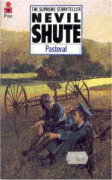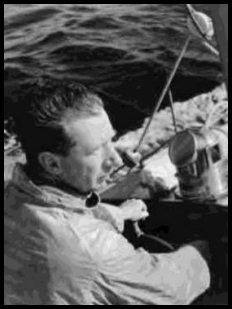By Dan Telfair
Part I
In 1948, British aviation engineer, pilot, and writer, Nevil Shute decided to visit Australia. There was nothing particularly unusual in that. What was unusual was that he decided to fly his four cylinder Percival Proctor from England to Australia, all about eastern Australia, and back to England. He almost made it, ground looping the Proctor in Italy on the final leg of his journey home. The details of this remarkable journey are documented in Nevil's flight log and in 'Flight of Fancy', by James Riddell, another writer who went along on the trip. While in Australia, Nevil flew all over the eastern half of the continent, taking notes and developing ideas for later novels. Some of his best known books, including 'On The Beach', 'The Far Country', and 'A Town Like Alice', were set in locations and peopled with characters he encountered along the way.
In March of this year, my wife Zia and I hosted a convention for Nevil Shute fans in Frankston, Victoria, near where Nevil Shute made his home and lived the last ten years of his life. Why we, who live in Albuquerque, New Mexico, were hosting a convention in Australia, is another story. My previous total exposure to Australia was one week's R&R in Sydney during Viet Nam. Zia had never been there at all.
While planning for the convention, I pulled out a map of Australia and Nevil Shute's flight log. Originally, the idea was to develop themes for the convention. However, having recently earned my fixed wing PPL, I was struck with the idea of repeating that portion of Nevil's flight that covered Australia. Looking at the map, it seemed simple enough and, after all, this was in the planning stages and there was always plenty of time to back out. Things rapidly got out of hand. By the time we left for the convention, we had already contacted the Royal Victorian Aero Club (RVAC) in Melbourne, and arranged to get a local checkout, obtain Australian pilots' licenses, and rent a Cessna 182.
After spending several weeks in Frankston preparing, conducting, and closing out the convention, we headed for Moorabin Aerodrome, just outside of Melbourne, to get our Australian flight rules orientations, flight checkouts, and licenses. That is when the fun began. When we started, I had about 300 hours fixed wing time on my PPL, although I had flown helicopters in the Army almost thirty years before. Zia had a total of around 200 hours. Neither of us were what you might call high time or experienced pilots.
The RVAC has a fleet of very well maintained aircraft and a cadre of experienced instructors. There were only two sources of confusion. They didn't know what we didn't know, and we didn't know what we were supposed to know. It took a couple of days for us to get all that sorted out. Basically, the only real problem for a US pilot flying in Australia is that the sources of information are different from those in the US. They have virtually no sectionals. The WACs, which are the primary VFR navigation charts, don't show any airport data, frequencies, navaids, controlled airspace, restricted or danger areas, etc. In other words, none of the data that are at our finger tips on sectionals and WACs in the US is available on VFR charts in Australia. However, all that information, and all other information necessary for flying there, is readily available elsewhere. It just took us a few days to figure that out. Similarly, there are differences in obtaining weather, filing and closing flight plans, and communications. They even have different airfield designations, and rules for each. Once you get all that sorted out though, it is just as easy as flying in the US. In fact, it is a good bit easier.
(If anyone would be interested in some free advice on Aussie flight rules, charts, other sources of information, airport and airspace designations and rules, how to obtain weather and file flight plans, how to arrange for fuel at outback airstrips, costs involved, etc., please contact us at our e-address: WDTelfair@aol.com. Zia and I are not experts on Aussie flight rules, but we have become somewhat expert on the essential differences between flying in the US and in Australia.)
In addition to learning local rules and procedures, we had to be checked out by one of the club's CFIs. Since we planned to do most of our flying in the Outback, the checkout included landing on small, unimproved strips. For this exercise, Elly, our CFI, took us to Coldstream, a small private strip not far from Moorabin. Suffice it to say, had she not told me to land there, I would never have attempted it. When we were dead center on the strip, which was a sort of white gravel, there were less than two feet on each side of the main gear. It wasn't just a matter of the wings extending beyond the edges of the strip. The struts extended beyond the edges of the strip! We never landed on anything quite that small on our subsequent travels, but the confidence gained there helped in several tight landings that followed.
Having learned our way around Aussie flying rules and satisfied Elly that there was at least a good probability that we would bring their Cessna 182 back in one piece, all that remained was to obtain our Australian licenses. That took about thirty minutes, and was a matter of presenting US licenses, medical certificates, and log books. Australian licenses cost around $25 each, and are good for life.
By March 31, we were ready to begin our flyabout. The RVAC had rented us a 1979 182Q which was in excellent condition - straight out of a 100 hour inspection. Her registration number was TSU, so she immediately became Tango Sweetie. We loaded her up with survival water and rations, spare parts, and our considerable baggage, and prepared to be on our way. For navigation, she had VOR, DME and ADF. On the coast those are nice, but inland, you very quickly run out of navaid range. For insurance, the RVAC supplied us with a handheld Garmin GPSII. It was not an aviation GPS, but worked fine for our needs.
Although the initial intent was to follow Nevil Shute' route, we decided that modifications along the way were acceptable. We had planned to fly first from Melbourne to Adelaide before heading north, but decided that we had already had enough of big city life. After much debate, we decided to head for Arkaroola, a sheep station turned nature preserve, via a layover/fuel stop in Broken Hill.
Despite our pretrip jitters, our first flight went smoothly. Navigation was easy as was communication with Aussie ATC. (They talk funny but they talk SLOWLY and CLEARLY. What a change!) We made it out of Melbourne controlled airspace with no problems, hit every check point on the nose, and found Mildura, our first stop, without difficulty. After a break for a brown bag lunch, we flew the final leg into Broken Hill. Once again, the navigation was easy. In addition to our navaids, it was surprisingly easy to use the WACs for pilotage.
The reason we had chosen Broken Hill for an RON was that our Aussie instructor, Elly, said that it was a nice place - a really quiet Outback town in the desert. As it turned out, it was 'race weekend' in Broken Hill - every hotel room booked, and the town turned upside down for the weekend. Fortunately, there had been a cancellation at the Grand Guest House, a hotel first built in 1888. We had a nice room with antique (junque) furniture, a wash basin, and with showers and toilets down the hall. Because we were visiting Yanks and honored guests, they gave us a room close to the dunnies (johns).
At breakfast the next morning, we were introduced to everyone - race fans, horse owners, jockeys, et al. The female half of the hotel owners was busy keeping the breakfast bar resupplied, while her husband sat in the foyer/hall in his bathrobe drinking coffee and talking to all the guests. All in all, a great place to be, like most places we had seen so far in Australia.
When we first planned the Australia Outback route, we were determined to stay over roads for the whole trip - for ease of navigation, in order to have ready forced landing areas, and to guarantee that someone would be along eventually if we got into trouble. We violated that principle partially the first day on the trip to Broken Hill. On the way to Arkaroola, we abandoned it completely. We flew a direct track with not a road in sight for most of the trip, which included an expanse of forty miles or so across a salt lake bed. The plane was solid; navigation had been easy; and our confidence level had built up considerably. After that, we tried to avoid long segments without forced landing areas, but pretty much flew as we do in the US. Although we weren't on radar much of the time, we were usually in radio contact with ATC. We always filed what they call a SARTIME (search and rescue time). If we didn't close it in a timely manner, they would come looking for us.
We tracked out from Broken Hill's VOR/DME and NDB until we lost the signals and then continued on heading and time distance, aided by the GPS. Once again, we hit the airstrip right on the nose. After checking out the strip, we headed into the hills another fifteen kilometers to find the village. Following instructions in our AOPA Australia Guide, we buzzed the village and revved the engine a few times before calling them on their unicom. They answered immediately, being alerted by the overflight, and arranged to send a pickup down to the strip.
Back at the strip, we were surprised to find a corrugated iron hangar available, which they let us use. Our driver, Kim, gave us a running commentary on the way to the village. After registering, we were shown to a very nice room. We freshened up, and went to the main building, where we had lunch. Thereafter, we obtained a trail map and went on an 8 kilometer hike.
The terrain and even much of the vegetation is rather like parts of Arizona. We later learned that the cactus plants had been imported form the US for their ability to exist in arid and barren soil. However, plans now are to eradicate them and let everything return to native growth. On our walk, we saw numerous kangaroos. Their manner is much like the mule deer on the running trails in the Sandia Mountains where we live. They will generally look at you with curiosity until something startles them or until you get too close, and then they will go bounding away. We have been told that what we see here are euros, rather than kangaroos - a fine distinction lost on us as well as most other tourists. They all look like kangaroos, but they vary in size, coloring, etc.
That evening at dinner, we were joined by an American couple who have been in Australia for 30 years. They retired in Queensland a few years ago and now come down to Arkaroola in the fall each year to act as volunteer drivers and tour guides - a very nice couple. The next day, we went on an Outback Landrover tour through the nature preserve. After the tour, we retired to our room for flight planning. Our route the next day to Coober Pedy didn't offer any problems. It was relatively straightforward - about 250 nautical miles across open country, culminating in a landing at an uncontrolled Outback airstrip.


